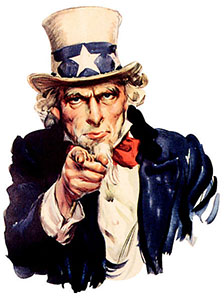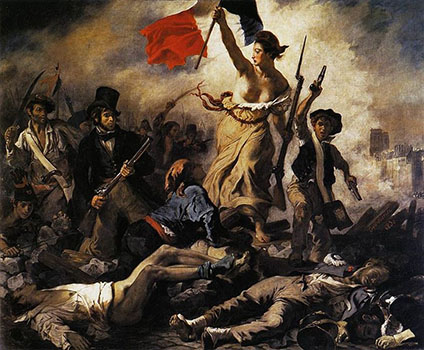Learn
Nationalism
Even though the great powers of England, Austria, Russia, and Prussia constructed a peace settlement intent upon returning peace, stability, and the balance of power on the continent, it seemed many segments of society were beginning to see themselves as distinctly unique people because of the cultural, linguistic language, and religious traditions they shared - basically, they saw themselves as part of a nation. That cultural oneness brought a strong feeling of pride in one’s own country.

Uncle Sam
You are now going to analyze how you can see these ideas illustrated in works of art. Specifically, you’re going to focus on examining images and symbols that represent nationalism pride, respect, and love of one’s country . To begin, think about this. What do you think of when you see the American flag, a picture of Uncle Sam, a soldier dressed in a military uniform? You probably see those as symbols of American patriotism—pride and respect for one’s country. That is also a form of nationalism, and you will explore that concept further in this lesson.

Concept of Nationalism
Look at the following concept map that defines the characteristics of nationalism.

Austria-Hungary
Keep in mind that nations across Europe would capitalize on ensuring that they focus on the cultural aspects that defined them as unified nations. One nation, the Austro-Hungarian Empire, also known as Austria-Hungary, was ruled by a Dual Monarchy - a ruler of Austria from the Hapsburg dynasty ruling both parts of the empire—that was not truly Austrian or Hungarian. It was comprised of people from eleven different ethnic backgrounds, preventing any possibility of shared culture, traditions, language, or religion.

Examples of Nationalism
Now it’s time to look for examples of nationalism in several paintings from 19th century France, and the newly established countries of Italy, and Germany. Analyzing a work of art is very much like reading a story. So in the next few paintings, you will, through close observation, read these paintings to find out the stories they have to tell you. As you look at each one, make a list of the symbols of nationalism you see in each.
Liberty Leading the People
As you know, the first painting, Liberty Leading the People, represents the events (specifically, the Revolutions of 1830) that occurred in France during the Age of Metternich - Europe from 1815 - 1848. Since you analyzed this painting extensively in lesson 6.05, refer back to it for a quick review. Eugene Delacroix painted this work to commemorate the Revolution of 1830 which removed the Bourbon King Louis XVIII from the French throne. You know the historical context for this painting, but look at the details in it, by describing the scene and identifying the images and symbols you see.

| Description | This is a scene depicting a battle. The dead represent those who gave their lives for the cause of freedom. The fighters represent the different social classes fighting for the cause. The man in the suit and top hat represents the middle class. The others fighters - the worker and young boy - are carrying guns, and they represent the lower classes. The three main figures are looking with determination into the eyes of Lady Liberty. It suggests that all social classes are unified in their fight for liberty. |
|---|---|
| Images, symbols |
|
Freedom Fighter

| Description | The "freedom fighter," Giuseppe Garibaldi, with ships in the background, is arriving on the shores, of Italy to unify the country. Notably, he is holding the Italian flag in his left hand, while he grasps a sword in his right hand. |
|---|---|
| Images, symbols |
|